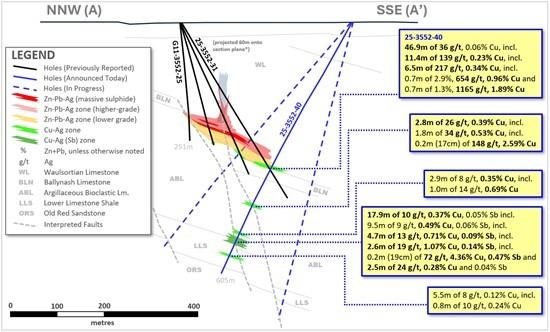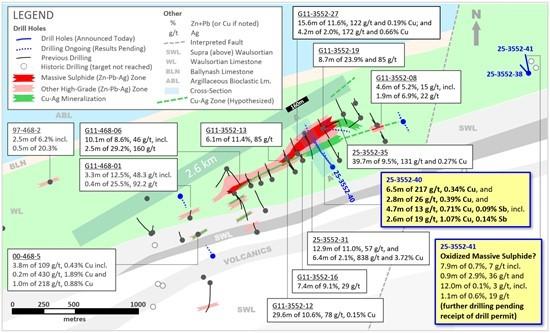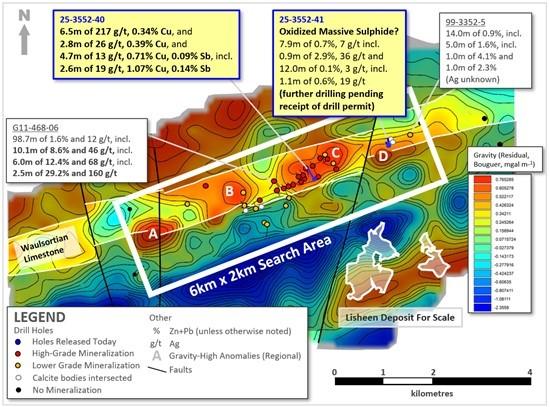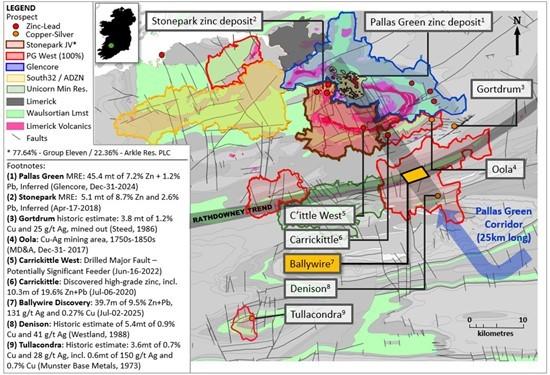
Group Eleven Drills 6.5m of 217 g/t Ag and 0.34% Cu; and 2.6m of 19 g/t Ag, 1.07% Cu and 0.14% Sb, Confirming Deeper Cu-Ag (Sb) Mineralization at Ballywire

Group Eleven Resources Corp. (TSX-V: ZNG) (OTCQB: GRLVF) (FSE: 3GE) is pleased to announce results from its first hole testing the ‘Deeper Cu-Ag Target’ at its Ballywire discovery at the 100%-owned PG West Project, Republic of Ireland.
Highlights:
- 25-3552-40 (filling a 160m gap in previous drilling, while testing the discovery horizon at the base of the Waulsortian Limestone and 250m below it) intersected intermittent mineralization over 240m, including:
- Cu-Ag Intercept (hosted within the base of the Waulsortian Limestone)
- 11.4m of 139 g/t Ag and 0.23% Cu (starting from 340.0m downhole), including
- 6.5m of 217 g/t Ag and 0.34% Cu, including
- 0.7m of 654 g/t Ag and 0.96% Cu and
- 0.7m of 1,165 g/t Ag and 1.89% Cu
- Cu-Ag Intercepts (at the ‘Deeper Cu-Ag Target,’ below the Waulsortian Limestone)
- 2.8m of 26 g/t Ag and 0.39% Cu, (from 441.3m downhole), including
- 1.8m of 34 g/t Ag and 0.53% Cu, including
- 0.2m (17cm) of 148 g/t Ag and 2.59% Cu, and
- 17.9m of 10 g/t Ag and 0.37% Cu, (from 516.9m downhole), including
- 4.7m of 13 g/t Ag, 0.71% Cu and 0.09% Sb, including
- 2.6m of 19 g/t Ag, 1.07% Cu and 0.14% Sb
- Results confirm presence of Cu-Ag (Sb) mineralization in the ‘Deeper Cu-Ag Target’ below the base of the Waulsortian Limestone, in line with Group Eleven’s exploration model
- Two follow-up holes, to the NNW and SSE of the above hole, respectively, are underway
- Cu-Ag (and locally Sb) mineralization consists of chalcopyrite and suspected tennantite-tetrahedrite occurring as disseminated mineralization and/or within calcite veins; mineralization appears to be related to a south-dipping fault zone (pierced by today’s drill hole) which is associated with Zn-Pb-Ag mineralization stratigraphically higher up (at the base of the Waulsortian Limestone)
“This is the first test of our hypothesized ‘Deeper Cu-Ag Target’ and we are thrilled that it has borne fruit,” stated Bart Jaworski, CEO. “With a viable new Cu-Ag target below our existing Zn-Pb-Ag horizon, our exploration potential has essentially doubled. We are gearing up to expand on this deeper discovery not only up and down dip, but also along our 2.6km-long strike-length of robust zinc mineralization pierced by drilling to date. As per our nearby geological analogues at Gortdrum, Denison and Tullacondra, fault-controlled Cu-Ag mineralization tends to strengthen with increased shattering along the structure. Further drilling at the ‘Deeper Cu-Ag Target’ will aim to identify these features. With three rigs turning each on excellent targets at Ballywire, a fourth rig likely to be added soon and a recently bolstered cash position, Group Eleven is poised to keep generating shareholder value through the drill bit for the foreseeable future.”

Exhibit 1. Cross Section of Deeper Cu-Ag Target Showing Hole 25-3552-40
Note: *Fence of holes G11-3552-25 to -31 is projected 60m onto the section plane; true thickness of intervals in 25-3552-40 as a percentage of down-hole interval, is estimated to be 80-100% (taking into account variability of vein orientations).

Exhibit 2. Plan Map of Ballywire Discovery Showing New Drilling and Location of Above Section
Note: Hole 25-3552-38 returned trace sphalerite and galena over approx. 12m, near the base of the Waulsortian Limestone
Ballywire Drill Update
The Ballywire prospect at the Company’s 100%-owned PG West Project in Republic of Ireland, represents the most significant mineral discovery in Ireland in over a decade. First announced in Sept-2022, the discovery has 59 holes drilled and reported by Group Eleven to date, including the most recent three holes (25-3552-38, -40 and -41) reported today (see Exhibits 1 to 4). Drilling to date at Ballywire has pierced robust mineralization over a 2.6km strike-length, along a prospective trend of over 6km (defined by four regional gravity-high anomalies, only one of which has been systematically drill tested to date; see Exhibit 4).
Today’s results from hole 25-3552-40 confirm that Cu-Ag mineralization exists below the base of the Waulsortian Limestone, in line with Group Eleven’s ‘Deeper Cu-Ag Target’ exploration model. Assay results are summarized in Exhibit 3. In addition to the description above, it is noteworthy that at least one large (19cm wide) tennantite-tetrahedrite-bearing calcite vein is bedding parallel, whereas other similar but narrower veins tend to be more irregular in orientation.
Two additional holes have been released today. Holes 25-3552-38 and -41, drilled 1.3km to the NE, near gravity-high anomaly ‘D’ (see Exhibits 2 and 4), also returned significant results.
Hole 25-3552-41 intersected what is interpreted as oxidized massive sulphide mineralization within a fault zone. Despite being highly weathered, the interval returned highly anomalous metal concentrations: (i) 7.9m of 0.74% Zn+Pb (0.57% Zn and 0.17% Pb) and 7.4 g/t Ag (starting at 229.5m downhole), including 0.9m of 2.87% Zn+Pb (2.43% Zn and 0.44% Pb) and 35.9 g/t Ag; and (ii) 12.0m of 0.13% Zn+Pb (0.06% Zn and 0.07% Pb) and 3.3 g/t Ag (starting at 258.2m downhole), including 1.1m of 0.55% Zn+Pb (0.21% Zn and 0.34% Pb) and 18.6 g/t Ag. These intervals (7.9m and 12.0m) contained weathered-out cavities totalling 19% and 40% of their respective downhole lengths (assumed ‘nil’ grade in the above weighted-average calculations). It is possible that these cavities represent evidence of preferential weathering due to original high levels of mineralization (e.g. massive sulphide). Hole 25-3552-38 returned trace sphalerite and galena (from approx. 231-244m downhole) near the base of the Waulsortian Limestone, also suggesting proximity to higher-grade mineralization.
Follow up drilling will resume at this locality once drill permits are received for the adjacent area, allowing more flexibility to systematically test the entire ‘Anomaly D’ target. This is the Company’s first test of this target area and given the above results, exploration potential has been confirmed. Today’s results, combined with: (a) mineralized historic hole 99-3352-5, (b) two shallow historic holes with abundant calcite (similar to calcite bodies associated with the massive sulphide at the discovery trend) and (c) the presence of the ‘D’ gravity anomaly itself (see Exhibit 4), add significantly to the prospectivity of this target.
Overall, three rigs are currently drilling at Ballywire, with a fourth rig expected soon. One rig continues to drill a fence of holes collared 200m east of hole G11-3552-08 (see Exhibit 2), testing for the easterly continuation of the mineralized trend. The second and third rigs are drilling along the section of holes containing G11-468-01 and 00-468-5 (see Exhibit 2) to test for a SW continuation of high-grade mineralization towards gravity-high anomaly ‘B’. Depending on results, the next fence of drilling testing the ‘Deeper Cu-Ag Target’ may be from this section. The fourth rig is likely to be geared towards reconnaissance drilling further outboard of the current mineralized corridor.
Currently, twelve new holes are completed or nearly completed (and in the process of being logged, sampled and assayed) as shown in Exhibit 2 (specifically, two holes near 25-3552-40; three holes near hole G11-3552-19; four holes collared approx. 200m NNW of G11-3552-08; and three holes on the drill fence hosting G11-468-01).
Exhibit 3. Summary of Assays from 25-3552-40 at Ballywire
| Item | From (m) |
To (m) |
Int (m) |
Zn (%) |
Pb (%) |
Zn+Pb (%) |
Ag (g/t) |
Cu (%) |
Sb (%) |
| 25-3552-40 | 311.91 | 358.83 | 46.92 | 0.33 | 0.11 | 0.44 | 35.7 | 0.06 | – |
| Incl. | 339.96 | 351.35 | 11.39 | 0.66 | 0.22 | 0.88 | 138.8 | 0.23 | 0.02 |
| Incl. | 339.96 | 346.43 | 6.47 | 0.73 | 0.22 | 0.94 | 217.4 | 0.34 | 0.03 |
| Incl. | 339.96 | 340.66 | 0.70 | 2.64 | 0.27 | 2.91 | 654.0 | 0.96 | 0.09 |
| Incl. | 345.78 | 346.43 | 0.65 | 0.90 | 0.36 | 1.26 | 1,165.0 | 1.89 | 0.15 |
| And | 441.28 | 444.05 | 2.77 | 0.03 | 0.00 | 0.03 | 25.8 | 0.39 | 0.03 |
| Incl. | 442.23 | 444.05 | 1.82 | 0.04 | 0.00 | 0.04 | 33.9 | 0.53 | 0.04 |
| Incl. | 442.85 | 443.02 | 0.17 | 0.15 | 0.00 | 0.16 | 148.0 | 2.59 | 0.16 |
| And | 453.55 | 453.88 | 0.33 | 0.00 | 0.01 | 0.01 | 16.8 | 0.33 | 0.01 |
| And | 493.25 | 494.23 | 0.98 | 0.05 | 0.00 | 0.06 | 15.3 | 0.69 | 0.08 |
| And | 508.31 | 511.18 | 2.87 | 0.03 | 0.01 | 0.04 | 7.7 | 0.35 | 0.05 |
| Incl. | 510.18 | 511.18 | 1.00 | 0.05 | 0.00 | 0.05 | 13.6 | 0.69 | 0.09 |
| And | 516.89 | 534.81 | 17.92 | 0.03 | 0.00 | 0.03 | 10.0 | 0.37 | 0.05 |
| Incl. | 516.89 | 526.34 | 9.45 | 0.04 | 0.00 | 0.04 | 9.4 | 0.49 | 0.06 |
| Incl. | 521.62 | 526.34 | 4.72 | 0.05 | 0.00 | 0.06 | 12.7 | 0.71 | 0.09 |
| Incl. | 521.62 | 524.17 | 2.55 | 0.08 | 0.00 | 0.08 | 19.2 | 1.07 | 0.14 |
| Incl. | 523.98 | 524.17 | 0.19 | 0.32 | 0.00 | 0.32 | 72.2 | 4.36 | 0.47 |
| And | 531.40 | 533.85 | 2.45 | 0.02 | 0.00 | 0.02 | 24.0 | 0.28 | 0.04 |
| And | 546.82 | 552.31 | 5.49 | 0.01 | 0.01 | 0.02 | 8.0 | 0.12 | 0.01 |
Note: True thickness of the mineralized interval in holes 25-3552-40 as a percentage of the down-hole interval, is estimated to be 80-100% (taking into account variability of vein orientations)

Exhibit 4. Regional Gravity Map Showing 6km Long Prospective Trend at Ballywire

Exhibit 5. Regional Map of Ballywire Discovery and Surrounding Prospects
Notes to Exhibit 5: (a) Pallas Green MRE is owned by Glencore (see Glencore’s Resources and Reserves Report dated December 31, 2024); (b) Stonepark MRE: see the ‘NI 43-101 Independent Report on the Zinc-Lead Exploration Project at Stonepark, County Limerick, Ireland’, by Gordon, Kelly and van Lente, with an effective date of April 26, 2018, as found on SEDAR; and (c) the historic estimate at Denison was reported by Westland Exploration Limited in ‘Report on Prospecting Licence 464’ by Dermot Hughes dated May, 1988; the historic estimate at Gortdrum was reported in ‘The Geology and Genesis of the Gortdrum Cu-Ag-Hg Orebody’ by G.M. Steed dated 1986; and the historic estimate at Tullacondra was first reported by Munster Base Metals Ltd in ‘Report on Mallow Property’ by David Wilbur, dated December 1973; and later summarized in ‘Cu-Ag Mineralization at Tullacondra, Mallow, Co. Cork’ by Wilbur and Carter in 1986; the above three historic estimates have not been verified as current mineral resources; none of the key assumptions, parameters and methods used to prepare the historic estimates were reported and no resource categories were used; significant data compilation, re-drilling and data verification may be required by a Qualified Person before the historic estimates can be verified and upgraded to be compliant with current NI 43-101 standards; a Qualified Person has not done sufficient work to classify them as a current mineral resource and the Company is not treating the historic estimates as current mineral resources. ‘Rathdowney Trend’ is the south-westerly projection of the Rathdowney Trend, hosting the historic Lisheen and Galmoy mines.
Qualified Person
Technical information in this news release has been approved by Professor Garth Earls, Eur Geol, P.Geo, FSEG, geological consultant at IGS (International Geoscience Services) Limited, and independent ‘Qualified Person’ as defined under Canadian National Instrument 43-101.
Sampling and Analytical Procedures
All core drilled at Ballywire is NQ (47.6mm) and is cut using a rock saw. Sample intervals vary between 0.17m to 1.41m with an average (over 243 samples) of 0.93m. The half-core samples are bagged, labelled and sealed at Group Eleven’s core store facility in Limerick, Ireland. Selected sample bags are examined by the Qualified Person. Transport is via an accredited courier service and/or by Group Eleven staff to ALS Laboratories in Loughrea Co. Galway, Ireland. Sample preparation at the ALS facility comprises fine crushing 70% < 2mm, riffle splitter, pulverise up to 250g 85% < 75um. Analytical procedures are 34 element four acid ICP-AES (codes ME-ICP61 and ME-OG62). Other than paying for a professional analytical service, Group Eleven has no relationship with ALS.
Quality Assurance/Quality Control Information
Group Eleven inserts certified reference materials as well as blank material, to its sample stream as part of its industry-standard QA/QC programme. The QC results have been reviewed by the Qualified Person, who is satisfied that all the results are within acceptable parameters. The Qualified Person has validated the sampling and chain of custody protocols used by Group Eleven.
About Group Eleven Resources
Group Eleven Resources Corp. is drilling the most significant mineral discovery in the Republic of Ireland in over a decade. The Company announced the Ballywire discovery in September 2022, demonstrating high grades of zinc, lead, silver, copper, germanium and locally, antimony. Key intercepts to date include:
- 10.8m of 10.0% Zn+Pb and 109 g/t Ag (G11-468-03)
- 10.1m of 8.6% Zn+Pb and 46 g/t Ag (G11-468-06)
- 10.5m of 14.7% Zn+Pb, 399 g/t Ag and 0.31% Cu (G11-468-12)
- 11.2m of 8.9% Zn+Pb and 83 g/t Ag (G11-3552-03)
- 29.6m of 10.6% Zn+Pb, 78 g/t Ag and 0.15% Cu (G11-3552-12) and
- 11.8m of 11.6% Zn+Pb, 48 g/t Ag (G11-3552-18)
- 15.6m of 11.6% Zn+Pb, 122 g/t Ag and 0.19% Cu (G11-3552-27)
- 12.0m of 1.4% Zn+Pb, 560 g/t Ag, 2.30% Cu and 0.17% Sb (25-3552-31), including
- 6.4m of 2.1% Zn+Pb, 838 g/t Ag, 3.72% Cu and 0.27% Sb (25-3552-31)
- 39.7m of 9.5% Zn+Pb, 131 g/t Ag and 0.27% Cu (25-3552-35)
Ballywire is located 20km from Company’s 77.64%-owned Stonepark zinc-lead deposit1, which itself is located adjacent to Glencore’s Pallas Green zinc-lead deposit2. The Company’s two largest shareholders are Michael Gentile (14.2%) and Glencore Canada Corp. (14.1% interest).
MORE or "UNCATEGORIZED"
Kuya Silver Confirms High-Grade Silver-Gold Vein Mineralization at Umm-Hadid with Initial Drill Results up to 1483.9 g/t AgEq over 2 Metres
Kuya Silver Corporation (CSE: KUYA) (OTCQB: KUYAF) (FSE: 6MR1) is... READ MORE
First Phosphate Closes Final Tranche of Oversubscribed Private Placement
First Phosphate Corp. (CSE: PHOS) (OTCQX: FRSPF) (FSE: KD0) is... READ MORE
GFG Receives Final Payment from the Sale of its Rattlesnake Hills Gold Project
GFG Resources Inc. (TSX-V: GFG) (OTCQB: GFGSF) announces that i... READ MORE
Goliath Receives $1,730,882 Through Warrant Exercises, Inclusive Of Crescat Capital A Longtime Strategic And Cornerstone Shareholder
Goliath Resources Limited (TSX-V: GOT) (OTCQB: GOTRF) (FSE: B4IF)... READ MORE
Robex Pours First Gold at Kiniéro on Schedule and Budget
Highlights: Gold bar weighing 2.64 kilograms (85 oz) poured in th... READ MORE












